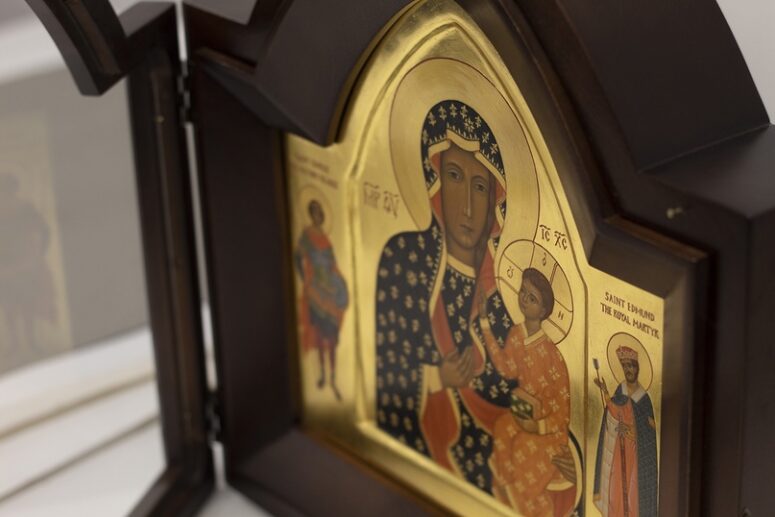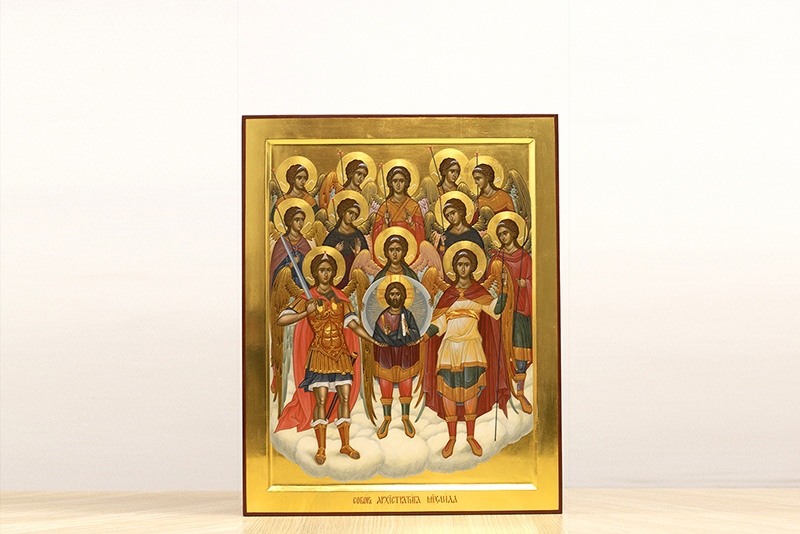
Many people think that caring for religious icons is as simple as putting it anywhere in the house and wiping dust off it as needed. In reality, however, if you would like to preserve your icon for many years, and, perhaps, even make it your family heirloom, you need to provide very specific storage conditions and care measures.
First of all, it is necessary to ensure the optimal temperature (+ 17-22 ° С) and humidity (50% -65%) in the room where the icon is stored. Any changes in temperature or humidity exceeding 10% must be excluded. The room should be ventilated gradually, drafts should be avoided. Icons should not be placed close to batteries and heaters, or exposed to direct sunlight. Failure to comply with these requirements will lead to cracking and shedding of the paint and the foundation layers. If your region of residence is characterized by low (high) humidity, consider purchasing a humidifier (dehumidifier).
If you hang an icon on a wall made of anything other than wood, you need to leave a gap between the icon and the wall for air circulation. Otherwise, with high humidity, the back of the icon may become moldy or cracked.
Icons should never be placed near burning candles or icon lamps, first of all for reasons of fire safety. Besides, the paint layer of such an icon can be damaged by the excessive heat and becomes contaminated with soot, which would then have to be removed by a professional restorer.

Naturally, over time, a layer of dust builds up on any icon. To avoid damaging the paint, never wipe (with wet or dry cloth), rinse, or polish icons with tooth powder, polishing paste, alcohol, oil varnishes, or any other means. Kissing an icon regularly also gradually damages its paint layer.
Icons should be cleaned from dust with a thick, dry, soft brush (preferably made of squirrel hair). This should be done regularly, but not more than once a month (so as not to damage the image).
The best solution to the above problems would be to buy an icon-case. This would reduce the influence of temperature and humidity variations and protect your icon from dust, soot and the physical impact caused by venerating it. An icon-case should have small openings allowing the icon to “breathe” (it still makes sense to remove it once in a while to ventilate the icon). The distance between the icon surface and the icon-case glass must be at least 3 cm, and the icon’s splines should not be resting against the walls of the case.
Icons should be protected from insects (flies and roaches, as well as furniture beetles).

Flies and cockroaches can eat the paint layer. Moreover, fly excrement has acidic properties and reacts with the paint layer. The results of such infestation can be as bad as paint damage going all the way down to the gesso layer. If you see clusters of small, slightly bulbous dots on an icon, this is probably it. In this case, if you cherish the icon, you should clean it urgently. This needs to be done professionally, however, to avoid damaging the paint.
The damage caused by furniture beetles is worse yet. Most often, these insects settle in old antique wooden furniture or interior items. But even if there are no such items in your home, it is still worth checking for damage, which usually appears in the form of circular or oval holes, seen more often on back or side panels. If you put a damaged item with the holes facing down, and lightly knock on its sides, you will see wormhole dust sprinkle out of them. If no measures are taken, the beetles will bring the icon to a state where it will be almost impossible to restore it. If you find such holes, contact a specialist urgently. Even if there are no traces of beetles, check your icon for their presence from time to time (for example, when cleaning it from dust every month).
Let’s summarize all of the above. In order for an icon to live as long as possible, a number of fairly simple rules should be observed, all of which boil down to limiting the influence of the external environment directly on the icon. If something is wrong with your icon, for example, the paint has faded, a layer of dust or dirt has formed that cannot be brushed off, or there is mechanical damage, then it is best to contact a professional restorer. Due to technical nuances, it is very important to find a restorer trained to work particularly with icons, since amateur performance will often cause even greater problems.





Thank you! Is maintenance more forgiving on the “powdered” version of the icons on marble slabs?
Yeah, it is. Don’t you worry, it is not as scary as it may seem. Just stick to the rules and everything should be fine
Thank you. I am a new convert to Orthodoxy currently going through my chrismation process. I was gifted two icons. I do not have an icon corner yet and am trying to find somewhere I can venerate them. In the mean time I have one on my kitchen counter (away from moisture) but I feel this may be disrespectful. In the coming days I am making a place for them. Is it disrespectful not to have them displayed yet? I am going to put the Icon corner in my room because I am the only Orthodox in my family. Is it okay to use an electric lamp? Or can I just light candles before them while I am there praying to prevent fire? Thank you.
Thank you for your reply, Tara!
It is not disrespectful of you to keep the icon in your kitchen if you are thinking about finding a better place for it and if you’re sure it’s safe from moisture. Temporary storage is fine, however, if you would ultimately decide to just keep it there, it would not be that good. It works the same with not displaying icons, so try to make a suitable place as soon as possible. You can use an electric lamp, you can light candles during your prayers, whatever suits you. But traditionally we use vigil lamps during our prayers at home.
Feel free to ask us anything if you need help in Orthodox faith. May God bless you!
I have several beautiful Orthodox icons, which we love. We purchased them years ago at an antique show. and we’ve moved to Fredericksburg Virginia. We need to know if there are any places we can co tact to help repair one of our wooden icons? I’m not sure we could afford professional repair. Maybe you could let us know how we can preserve this icon before time causes more damage? A contact in Cypress said use varnish but he wasn’t sure. Maybe bees wax?
Polyurethane? Thanks in advance.
Hello, John!
Please contact st.elisabeth.shop@gmail.com. I guess our convent’s icon studio actually does restore old icons. And as far as my guess goes it would be much cheeper than in US. I remember a case when someone from Australia sent us his icon to have it restored. Anyway, contact the email above, you’ll get help anyways.
In Christ,
Rdr. John
Thank you so much for the contact info and for your quick reply. I also have a more spiritual question. What is the process for a Roman Catholic to convert to Greek Orthodox Church if it is even allowed. I attend mass every week but there are certain negative things about the RC Church. Thank you in advance.
You’re always welcome!
Well, you have to understand why you don’t want to be in RC Church anymore and why you want to be in the Orthodox Church. If your faith does not contradict the faith of the Orthodox Church and you want to convert, then you just visit an orthodox church and take part in the Sacrament of Penance. You have to refute the filioque, the dogma of papal primacy and etc. After participating in Penance, you can consider yourself a member of the Orthodox Church and take part in it’s services and Sacraments like any other member would. Children converting from catholicism need to take part in Chrismation (in case they were not chrismated in RCC). Feel free to ask any questions.
In Christ,
Rdr. John
Hello. I am not religious at all, but someone close to me gave me an orthodox icon to protect the house. Even not being religious, this was very special to me. I can’t explain why. They recently took this away again, during a dispute. Is this bad? Is it bad for them? I want it back in the house but I can’t have it. I am also concerned for them as they are a very devoted member of the orthodox church. Please advise.
Hello! Don’t you worry about it. Icons are not magical amulets or something, so they can’t bring something “bad” to you or your friend. Orthodox believe that icons are just depictions of Lord Jesus, angels or saints. By venerating them we venerate the one depicted, but not the image itself, as it is only an image. Of course we treat icons with care and reverence as we would do with depictions of our loved ones. That’s it. I’d recommend you to get a new icon. The one that would touch you the most. Just read the Gospel or the lives of saints and find an event or a person that would feel the most kindred to you. Who knows, maybe by this event God has called you and now wants you to begin your spiritual path. Feel free to ask any questions.
Wishing you well,
rdr. John
Will a damp environment damage an icon made on wood?
Unfortunately, yes.
Favorable conditions in the room for storing hand-painted icons:
✅ Optimal temperature in the room where the hand painted icon is stored should be around 17-22°C (62-72°F);
✅ Optimal humidity – 50-65%.
▶️These figures are usually present in residential apartments. If the environment experiences fluctuations in these indicators, especially during winter and summer, it is strongly recommended to place the hand painted icon in a kiot.
Kiot (or an icon case) is a special wooden box that protects the sacred image from humidity and temperature fluctuations, as well as unforeseen mechanical damage.